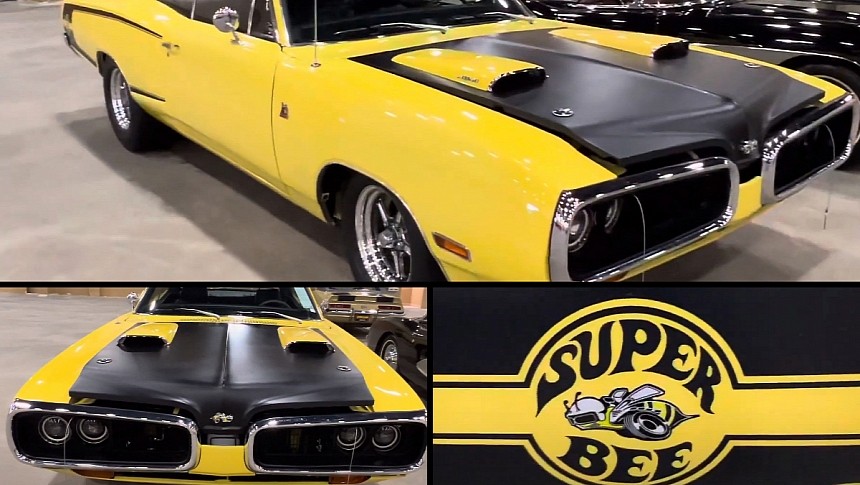Introduced in 1968 as a lower-priced alternative to the GTX, the Plymouth Road Runner became an instant hit, selling almost 45,000 units in its first year in dealerships. This prompted Dodge executives to request a similar model based on the Coronet. That's how the Super Bee was born.
The division's most affordable way into HEMI ownership, the Super Bee wasn't as successful as the Road Runner. However, the muscle car found 27,800 customers in 1969 and moved 15,506 units in 1970. The entry-level version with the 383-cubic-inch (6.3-liter) B-block was the most popular, but some Super Bees got the mighty 426-cubic-inch (7.0-liter) HEMI V8.
Only 125 examples were equipped with the range-topping unit in 1968, followed by 166 units in 1969. As sales decreased in 1970, so did interest in HEMI engines. Dodge delivered only 36 HEMI cars that year and sold only 22 in 1971. With 349 units made over four model years, the Dodge Super Bee is arguably one of the rarest HEMI rigs of the golden muscle car era.
These vehicles fetch six-digit prices at public auctions nowadays, with examples in Concours condition going beyond the $200,000 mark. The 1970 Super Bee you see here is not one of them, but it sure looks like a fine HEMI car from a distance.
A well-built trickster finished in what looks a lot like Lemon Twist yellow, this Mopar was dressed to mimic an authentic HEMI. It rocks a dual-scoop hood with "HEMI" badges, locking pins, and a black rear wing. However, the mill under the hood has nothing in common with the legendary 426 HEMI except for the name. Because it's a modern 392-cubic-inch (6.4-liter) lump of the third-generation HEMI variety. Yup, you're looking at a restomod that still retains much of its original appearance.
Get close enough, and you'll notice a few more alterations compared to the factory 1970 Super Bee. The car sits closer to the ground, it sports LED headlamps, while the "392" badges on the front fenders provide a hint about what's under the hood. The black interior is also stock at first glance, but the Procar bucket seats and the digital gauges add a modern twist.
The engine is a Mopar Performance crate unit paired with a Tremec TKX five-speed manual gearbox. It sends oomph to the wheels via a Truetrac rear end with 3.91 gears. There's no info on oomph, but Mopar rates this V8 at 485 horsepower, which is notably more than a vintage 426 HEMI. And since it also features a Hellcat oil pump and possibly other upgrades, it's safe to assume that it cranks out more than 500 horsepower.
All told it's not one of those 36 1970 HEMI Super Bees most collectors are chasing nowadays, but it's just as spectacular and significantly faster down the quarter-mile. Check it out in the video below.
Only 125 examples were equipped with the range-topping unit in 1968, followed by 166 units in 1969. As sales decreased in 1970, so did interest in HEMI engines. Dodge delivered only 36 HEMI cars that year and sold only 22 in 1971. With 349 units made over four model years, the Dodge Super Bee is arguably one of the rarest HEMI rigs of the golden muscle car era.
These vehicles fetch six-digit prices at public auctions nowadays, with examples in Concours condition going beyond the $200,000 mark. The 1970 Super Bee you see here is not one of them, but it sure looks like a fine HEMI car from a distance.
A well-built trickster finished in what looks a lot like Lemon Twist yellow, this Mopar was dressed to mimic an authentic HEMI. It rocks a dual-scoop hood with "HEMI" badges, locking pins, and a black rear wing. However, the mill under the hood has nothing in common with the legendary 426 HEMI except for the name. Because it's a modern 392-cubic-inch (6.4-liter) lump of the third-generation HEMI variety. Yup, you're looking at a restomod that still retains much of its original appearance.
Get close enough, and you'll notice a few more alterations compared to the factory 1970 Super Bee. The car sits closer to the ground, it sports LED headlamps, while the "392" badges on the front fenders provide a hint about what's under the hood. The black interior is also stock at first glance, but the Procar bucket seats and the digital gauges add a modern twist.
The engine is a Mopar Performance crate unit paired with a Tremec TKX five-speed manual gearbox. It sends oomph to the wheels via a Truetrac rear end with 3.91 gears. There's no info on oomph, but Mopar rates this V8 at 485 horsepower, which is notably more than a vintage 426 HEMI. And since it also features a Hellcat oil pump and possibly other upgrades, it's safe to assume that it cranks out more than 500 horsepower.
All told it's not one of those 36 1970 HEMI Super Bees most collectors are chasing nowadays, but it's just as spectacular and significantly faster down the quarter-mile. Check it out in the video below.













